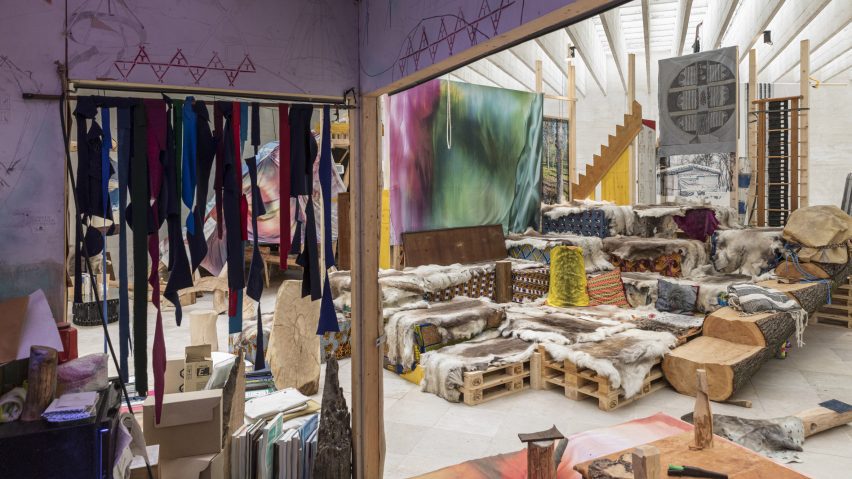A nomadic library created by architect Joar Nango that contains 15 years of material highlighting Indigenous Sámi architecture forms the basis of the Nordic Countries Pavilion at the Venice Architecture Biennale.
Titled Girjegumpi: The Sámi Architecture Library, the pavilion was designed by Joar Nango alongside numerous collaborators, commissioned by ArkDes and curated by Carlos Mínguez Carrasco and James Taylor-Foster.
It centres around a nomadic library that includes over 500 books collected by Sámi architect Nango. The Sámi are Indigenous people living in the traditional region of Sápmi, and the books focus on their architecture and design.
The material is an ever-growing collection that Nango has accumulated over a period of 15 years, which aims to highlight issues surrounding activism, traditional building methods and Indigenous architecture and design.
"Five years ago, I realised that I had so much material that I need to share with the world," Nango told Dezeen.
"I built this small little moveable shack, which is called a gumpi, an informal type of architecture that's very common," he continued. "We build small buildings and put them on skis, so you can pull them behind the snowmobile."
Alongside the library, the pavilion also includes artworks, film, materials and found objects. Each piece of archival material invites visitors to learn about and engage with topics such as decolonisation, sustainability, climate change and reuse.
"Girjegumpi is an inviting and playful series of spaces, installations, and details – and its dialogue with the pavilion itself is unique," curators Taylor-Foster and Carrasco told Dezeen.
"There is an inherent warmth to the room that is built from conversation and collaborations that are much larger than the Biennale," they continued. "Whether visitors attend a gathering or come for an afternoon of reading, Girjegumpi provides different kinds of ways into understanding and experiencing architecture in Sápmi."
Taylor-Foster and Carrasco hope that the pavilion will become a "social space" for visitors.
"At its heart, Girjegumpi is a social space – a place to gather, to sit, to read," they said.
"We think that the visitors will be struck by the materiality, the smells, the sounds," the curators continued. "The soundscapes of Sápmi by Anders Rimpi that bathe the entrances to the pavilion set the tone."
The Sámi people are descendants of nomadic communities who inhabit the northern regions of Norway, Sweden, Finland and Russia's Kola Peninsula – which is otherwise known as the traditional territory of Sápmi.
According to Nango, "Sámi architecture is something that we need to talk about", and he hopes the Biennale will encourage this.
"We need to understand what it is and to create a social network around it, we need to dive deeper into it, we need many people involved in it," he explained.
"It's not only for Sámi people, it's also for all architects to think about what is our colonial heritage in Europe."
Girjegumpi takes its name from two Sámi words. The first, girji, means book, and the second is gumpi – the type of informal building on which he modelled the library.
The name references both the function of the library and its travelling nature as it continues to relocate across different locations, which it has been doing since 2018.
"Since 2018, it has journeyed around Sápmi and, more recently, the wider Nordic region," said Taylor-Foster and Carrasco. "Its journey to Venice is the furthest it has travelled so far, and the project will return to Sápmi at the close of the Biennale."
"Everywhere Girjegumpi travels, it adapts and expands," said Taylor-Foster and Carrasco.
Åserud
Reflecting on the project, Nango said he hopes the Biennale will be a "great place" for the archive.
"I think Venice is a great place to connect and to raise important questions," said Nango.
"These types of questions about Sámi architecture, what it is, the colonial history of northern countries, who we are," he said. "Sámi people are colonised people, but our lands are still being expropriated."
When the nomadic library is not travelling, it is based at Sámi Dáiddaguovddáš, the Sámi Centre for Contemporary Art in Karasjok, Norway.
A number of pavilions at the Venice Architecture Biennale were revealed exclusively on Dezeen last week, including the Swiss Pavilion, the Brazilian Pavilion and the Australia Pavilion.
The photography is by Astrid Fadnes, unless stated otherwise.
The Venice Architecture Biennale takes place from 20 May to 26 November 2023. See Dezeen Events Guide for all the latest information you need to know to attend the event, as well as a list of other architecture and design events taking place around the world.
Project credits:
Lead designer: Joar Nango
Commissioner: ArkDes
Curators: Carlos Mínguez Carrasco and James Taylor-Foster
Collaborators: Håvard Arnhoff, Ken Are Bongo, Petter Bratland, Stefano Crosera + Margherita Pasqualato (Cantiere Daniele Manin), Mathias Danbolt, Ole-Henrik Einejord, Astrid Fadnes, Jenni Hakovirta, Eirin Hammari, Elin Haugdal, Petri Henriksson, Tone Huse, Robert Julian Hvistendahl, Iver Jåks + Jon Ole Andersen, Anne Kare Kemi, Annik Kristiansen Hagen, maka design, Grete Johanna Minde, Karen Inger Anne Nango, Nils John Nango, Anne Henriette Nilut, Ole Thomas Nilut, Raisa Porsanger, Tobias Aputsiaq Prytz, Anders Rimpi, Katrine Rugeldal, Wimme Saari, Sámi Architecture Dictionary Group, Arne-Terje Sæther, Katarina Spik Skum, Mary Ailonieida Sombán Mari, Četil Somby, Anders Sunna, Anna-Stina Svakko, Eystein Talleraas, Petter Tjikkom, Magnus Antaris Tuolja

